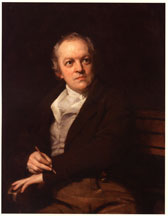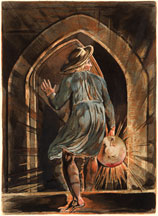November 2007 – February 2008
 The poet, printmaker, painter, and visionary William Blake (1757-1827) earned his daily bread as a commercial engraver, supplemented by occasional commissions as an illustrator of the Bible and of Milton and other poets. But his true vocation, virtually unknown in his lifetime, was the creation of an astounding body of self-published books composed “under the dictates of our Angels,” in a verbal-visual medium of his own invention, printed on his own rolling press. Invoking muses of a new sort to “Come into my hand . . . descending down the Nerves of my right arm / From out the Portals of my Brain” Blake called on his contemporaries – and still calls on “Children of the future Age” — to join him in reimagining the world. For him, visions of a lost paradise or a New Jerusalem are not escapist fantasies but insights into everyday reality as it could be if created anew by an awakened and energized people.
The poet, printmaker, painter, and visionary William Blake (1757-1827) earned his daily bread as a commercial engraver, supplemented by occasional commissions as an illustrator of the Bible and of Milton and other poets. But his true vocation, virtually unknown in his lifetime, was the creation of an astounding body of self-published books composed “under the dictates of our Angels,” in a verbal-visual medium of his own invention, printed on his own rolling press. Invoking muses of a new sort to “Come into my hand . . . descending down the Nerves of my right arm / From out the Portals of my Brain” Blake called on his contemporaries – and still calls on “Children of the future Age” — to join him in reimagining the world. For him, visions of a lost paradise or a New Jerusalem are not escapist fantasies but insights into everyday reality as it could be if created anew by an awakened and energized people.
Blake was well prepared for his life’s mission both by formal training in his craft and by self-education in the liberal arts, and he was always blessed by familial encouragement. Early on, his parents recognized his stubborn independence and artistic leanings. His father, a hosier and haberdasher, helped him purchase casts of antique sculptures, sixteenth-century prints, and books of poetry and philosophy. At ten, he entered drawing school; at fourteen, he began a seven-year apprenticeship in engraving; at twenty-one, he was admitted as a student to the Royal Academy. His father, a hosier and haberdasher, helped him purchase casts of antique sculptures, sixteenth-century prints, and books of poetry and philosophy. At twenty-five, on the rebound from a failed romance, he married Catherine Boucher, the daughter of a market gardener, and she soon learned to help him in his work, especially in coloring and presswork.
Blake read widely in philosophy, theology, history, and art theory and concerned himself deeply with the revolutionary events of his time, their causes and consequences. More explicitly than any English writer before him, he pointed out the interrelationship of individual and societal problems that link self-righteousness, hyper-rationalism, sexual frustration, repression of energy, cruelty, injustice, and revolutionary violence. With biblical prophecy as his model, he excoriated all social structures and belief systems that narrow perception and stifle the human spirit. In his later works, he embodied these and other ills in the nightmare-ridden figure of the cosmic giant Albion, or universal humanity, who has fallen into the deadly sleep of mundane existence. In humanity’s coma, the divine is a remote and forbidding sky-god; nature, a sterile heap of atoms; lovers and family members, enemies; and one’s own innermost being, an unrecognized alien.
 To heal Albion and reunite the “Eternal Great Humanity Divine” (Milton 44/39: 27), Blake created illuminated epics aimed at restoring to the rational mind its estranged faculties of intuition, imagination, and feeling; his purpose was (and is) to liberate humanity from illusory oppositions between divine/human, spiritual/ material, human/natural, self/other, male/female, and masculine/feminine elements within individuals. In everything he wrote and etched, he strove to arouse in each of us our full capacity to perceive, think, and act as whole persons belonging to the whole human race.
To heal Albion and reunite the “Eternal Great Humanity Divine” (Milton 44/39: 27), Blake created illuminated epics aimed at restoring to the rational mind its estranged faculties of intuition, imagination, and feeling; his purpose was (and is) to liberate humanity from illusory oppositions between divine/human, spiritual/ material, human/natural, self/other, male/female, and masculine/feminine elements within individuals. In everything he wrote and etched, he strove to arouse in each of us our full capacity to perceive, think, and act as whole persons belonging to the whole human race.
The exhibit is organized primarily by categories of work, secondarily by chronology, moving clockwise from the left side (east wall) of the lobby.
- Case 1, East wall: Shorter works in Illuminated Printing, 1789-95, 1818
- Case 2, South wall, east: Epic-length works of 1804-1820, Milton and Jerusalem
- Case 3, Southeast (freestanding): Blake’s only one-artist exhibit (with Canterbury Pilgrims), 1809
- Case 4, South center (freestanding): Songs of Innocence and of Experience (1789-94); portraits of the artist
- Case 5, South wall, west: Illustrations of the Book of Job (1823-26)
- Case 6, Southeast (freestanding): Illustrations of Paradise Lost (1816-20)
- Case 7, West wall: Commercial Engravings and Book Illustrations (1791-1821)
- Case 8, North center (freestanding): Dante, Whirlwind of Lovers (1826)
Acknowledgements
Exhibit Planning
Mary Lynn Johnson, John Grant, Eric Gidal, Judith Pascoe, Greg Prickman
Production and Installation Assistance
Greg Prickman , Bill Voss and Kristin Baum.
Graphic Design
Anne Craig and Greg Prickman
